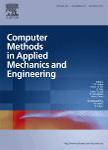版权所有:内蒙古大学图书馆 技术提供:维普资讯• 智图
内蒙古自治区呼和浩特市赛罕区大学西街235号 邮编: 010021

作者机构:Northwestern Univ Inst Technol Dept Mech Engn Evanston IL 60208 USA Polytech Univ MetroTech Ctr 6 Dept Mech Engn Brooklyn NY 11201 USA
出 版 物:《COMPUTER METHODS IN APPLIED MECHANICS AND ENGINEERING》 (应用力学和工程技术中的计算机方法)
年 卷 期:2004年第193卷第21-22期
页 面:2051-2067页
核心收录:
学科分类:08[工学] 0701[理学-数学] 0801[工学-力学(可授工学、理学学位)]
主 题:immersed finite element method reproducing kernel particle method fluid-structure interaction particulate flow immersed boundary method
摘 要:In this paper, the immersed finite element method (IFEM) is proposed for the solution Of Complex fluid and deformable structure interaction problems encountered in many physical models. In IFEM, a Lagrangian solid mesh moves on top of a background Eulerian fluid mesh which spans over the entire computational domain. Hence, the mesh generation is greatly simplified. Moreover, both fluid and solid domains are modeled with the finite element methods and the continuity between the fluid and solid sub-domains are enforced via the interpolation of the velocities and the distribution of the forces with the reproducing kernel particle method (RKPM) delta function. In comparison with the immersed boundary (1B) method, the higher-ordered RKPM delta function enables the fluid domain to have non-uniform spatial meshes with arbitrary geometries and boundary conditions. The use Of Such kernel functions may eventually open doors to multi-scale and multi-resolution modelings of complex fluid-structure interaction problems. Rigid and deformable spheres dropping in channels are simulated to demonstrate the unique capabilities of the proposed method. The results compare well with the experimental data. To the authors knowledge, these are the first solutions that deal with particulate flows with very flexible solids. (C) 2004 Elsevier B.V. All rights reserved.